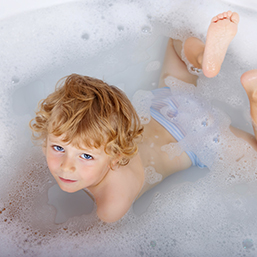
Water safety is one of the most valuable life skills you can give your child. While formal lessons at the pool are important, you don’t have to wait until your child is old enough for local classes to begin teaching the basics. Even in your bathtub, you can introduce simple water safety concepts right at home. These early at-home lessons not only help children feel comfortable around water, but also lay the foundation for safe habits that will stick with them for years to come.
\n \nBuild comfort first. For many children, the first step to water safety is simply feeling at ease around water, because ultimately, a child who is fearful of getting wet will find it hard to learn how to stay safe. Take your time with this process. Pour small amounts of water over your child’s arms, shoulders, and back so they get used to the feeling. Encourage splashing, kicking, and playing with toys in the tub. As their comfort grows, so will their confidence. A confident child is more likely to listen to you and practice safety instructions when it matters most.
\nBegin with breath control. The bathtub is the perfect place to introduce your child to the idea of breath control. Breath control is the foundation of all swimming and water safety skills. At its simplest, it means understanding when to hold your breath and when to breathe.
\nWe teach this by doing cup submersions, mouth dips, and various exploration holds to give a new learner an understanding of breath control. Over time, your child will begin to understand what it feels like to go underwater for three seconds and come back up for air.
\nUse everyday safety points. In the pool, swimmers learn to use walls, floats, and other safety points. At home, you can re-create these ideas in a way that makes sense for a bathtub setting. For example:
\nThese small, familiar exercises help children connect the idea of safety with water, even before they are in a larger swimming environment.
\nMake it fun. The best way to teach water safety at home is to make it fun. Always get into the water with your child and make the experience playful. Turn skills into games and let your child’s imagination take the lead. Try singing songs together; songs help calm swimmers, create a rhythm, and allow them to focus on their breathing. Play with water-safe toys and pretend you’re underwater explorers. Count to three and see who can dip their face in first. Celebrate every little success with high fives, laughter, and encouragement. When learning feels like play, children are more engaged and more likely to remember the skills they are practicing.
\nKeep safety top of mind. Even as you introduce these activities at home, remember that water safety is an ongoing process. Children should never be left alone in the bath, even for a moment. Always be prepared to stay in the bathroom with everything you need: a towel nearby (not down the hall), and your phone within reach but never used (only kept close in case of emergencies). Encourage your child to take breaths through their mouth after each submersion. Count the coughs or sneezes that follow, allowing up to four per practice.
\nIf your child has more, stop submersions and switch to a different activity. The goal of these exercises is to build awareness and comfort, not to replace supervision. As your child grows, swim lessons and continued practice will further strengthen their safety skills.
\nA foundation for life. Introducing swim safety at home gives your child the tools they need to approach water with both confidence and caution. By practicing breath control, teaching them about safety points, encouraging comfort, and making it fun, you are setting them up for success before they even set foot in a swimming pool.
\nWater is powerful, and helping children learn how to respect it in small, playful ways at home is one of the best gifts you can give them.
\nIf you’re looking for more support or to learn more on this topic, you can explore parent-and-tot swim lessons (watermellow.ca) online, where instructors guide you step by step to teach your own child at home, helping you introduce water safety skills in a fun and confident way.
\n\n
Kaylee is a mom of two, swim educator, and swim school owner who is passionate about helping families build strong foundations in water safety. With years of experience teaching children how to swim, Kaylee believes that confidence and comfort in the water begins at home, long before formal swim lessons start.
\n\n
See our related articles:
\nCalgary’s Child Magazine © 2025 Calgary’s Child